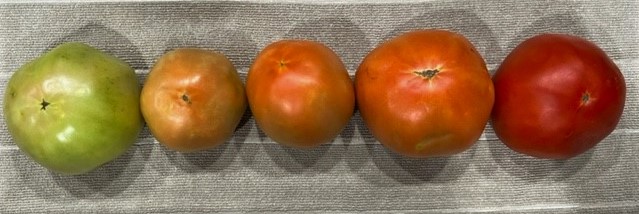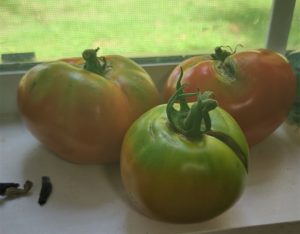Pick tomatoes at color break
Ripening off the vine extends harvest, quality with no taste difference
Home gardeners should pick tomatoes sooner than later.
There is a common misconception among the public and home gardeners that vine-ripened tomatoes taste better. But picking tomatoes at color break does not hurt quality, reduces fruits’ exposure to damage and can extend their shelf-life, according to a Texas A&M AgriLife Extension Service expert.

Larry Stein, Ph.D., AgriLife Extension horticulturist, Uvalde, said tomatoes are fully mature when they begin to break color. Tomatoes ripen as they begin to produce ethylene gas, which promotes the process.
“Breakers,” mature tomatoes starting to change colors, begin to turn a yellowish green and then begin to fade into salmon-to-pink hues before turning red. Tomatoes can be picked as soon as their green begins to yellow.
There is a difference in taste and quality between some commercially produced tomatoes, but it is based on logistical necessities that do not apply to home gardeners, Stein said.
For instance, many commercially grown tomatoes are picked green for shipping, then treated with ethylene gas or placed in “ripening rooms” to promote ripening. Harvests of commercial tomatoes in Texas bound for markets around the state may include a range of fruit break – from yellowing to ripe – because bulk picking and shipping is the only feasible option.
There is a difference between tomatoes picked green and ripened via synthesis, Stein said, but no taste or tenderness difference between tomatoes pulled from the vine at color break and those allowed to reach full red color on the vine.
“Over the years, the term ‘vine-ripened’ may have emerged as a branding tactic used to make something sound better or set a product apart, but it is just a marketing ploy when it comes to tomatoes,” Steins said. “The fruit is fully mature at break, and there are no benefits from leaving it on the vine, but there are drawbacks.”
Picking tomatoes earlier reduces risks, damages

Stein said he has picked his own tomatoes at the first hint of color change for decades. It is standard operating procedure to reduce fruit damage or losses in his garden and his recommendation to gardeners.
Harvesting at color break reduces the chance of pests like stinkbugs and birds harming the fruit, he said. Breaker tomatoes are also less likely to experience radial cracks, splits in the fruit related to water uniformity.
Radial cracks occur because moisture availability is not consistent, Stein said. Fruit swells and cracks when soils receive excess water following very dry conditions.
Some gardeners believe birds target tomatoes and other garden vegetables for their water content, especially during drought, Stein said. He doesn’t have any data to suggest those beliefs to be right or wrong, but he did say birds target redness.
Picking at break will not prevent all blemishes from stinkbugs but it will reduce exposure to varmint and pest damages, including burrowing pests like fruitworms.
Earlier harvest will also reduce fruits’ exposure to high winds and other various contributors to bruising, he said.
“There are so many reasons to pick tomatoes at color break, and no reason not to,” he said. “It’s just how I have done it forever.”
Storage and ripening
Stein said picking at color break can also allow gardeners to better extend their harvests. The shelf life of ripe tomatoes can be extended in a refrigerator. Refrigerating tomatoes picked earlier in the ripening process puts the ethylene gas production on hold.
Stored tomatoes can then be sequentially ripened at the gardeners choosing. To ripen tomatoes, Stein suggests placing them on a countertop at room temperature. The process should take five to seven days from color break.
“There will be naysayers, but there is no science to support ripening on the vine,” he said. “The quality will be as good, if not better, ripening your tomatoes off the vine rather than on the vine.”


